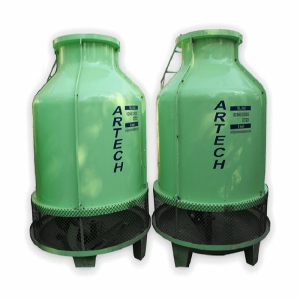7 Major Components of the cooling TowerPosted by Uday Shah on December 21st, 2022  After decades of technological scientific development, cooling towers are now available in a variety of kinds and sizes. With various designs, they use different components but there are major parts that are used in every tower. A few common cooling tower components are listed below: Cooling Fan: Large fans that move a lot of air may be found inside a cooling tower. Many industries use fanless cooling towers, and many of them do create and control the airflow within the tower. Depending on the given particular requirements of the application, they may be axial or centrifugal and may push or pull air through the tower. Centrifugal fans are quieter and better able to handle higher static pressure levels, while axial fans are more effective. Fill Space: It is also known as wet deck or surface, is a crucial component of how cooling towers work and is often made of textured polyvinyl chloride (PVC). It typically has ridges with gaps for the water and air to pass through. Its function is to encourage water to accumulate on it, increasing the water's surface area and promoting heat transmission between the water and the surrounding atmosphere. Fill space can be found in a few different varieties. The surface area of the stored water is increased by film-type fill by spreading it thinly. By fragmenting a falling stream of water into smaller droplets, splash-type filling expands the water's surface area. Spray nozzles: Increasing the water's surface area can also be done with the help of spray nozzles in the cooling tower. Some cooling tower designs, such as counterflow towers, use spray nozzles to disperse tiny water droplets into the atmosphere. The spray aids in distributing the water evenly across the fill, and the droplets offer a significant surface area for air interaction. Distribution basin: Crossflow cooling towers frequently utilise the distribution basin, also known as the hot water basin. The hot water is dispersed uniformly throughout the tower via a distribution basin in place of the spray nozzles. It typically consists of a pan with holes or nozzles along its base and is located atop the tower. Hot water enters via the top of the tower, where it is distributed uniformly over the fill material below through perforations or nozzles. Collection basin: To collect the water once it has cooled, the collection basin, also known as the cold water basin, is located at the base of the tower. These basins are frequently made of concrete in field-built replicas to handle the enormous weight of the water cascading down the tower. Inlets and Outlets: The cooling tower has inlets and outlets that draw cool air in from the outside environment and expel warm air once it has absorbed the heat from the water. Drift eliminators: While water loss or drift in an FRP square cooling toweris undesired, it can occasionally happen when stray drops of water fall into the outlet and evacuate with the air. Water is kept stable in the tower with the use of drift eliminators. To stop the airflow from sweeping water away, they direct it in a variety of ways. It should be noted that, despite the various designs, the fundamental purpose is still to transfer heat from a building system or a process to the air through evaporation. And these components are essential for effective use. Like it? Share it! |


